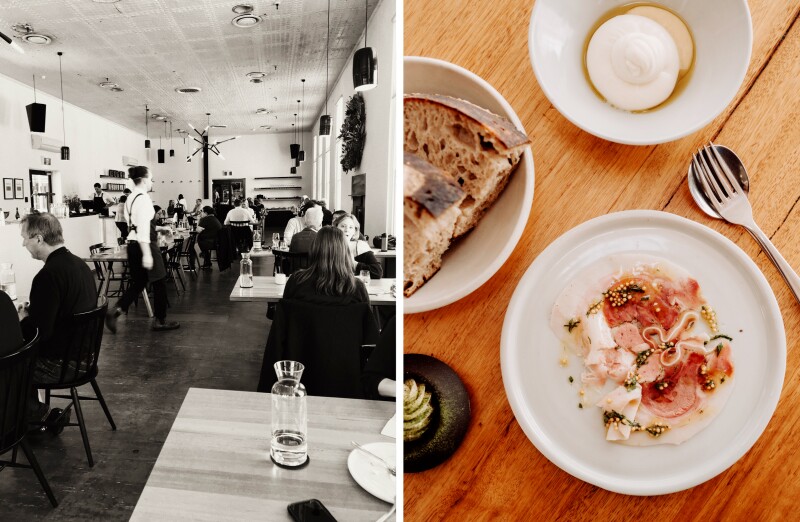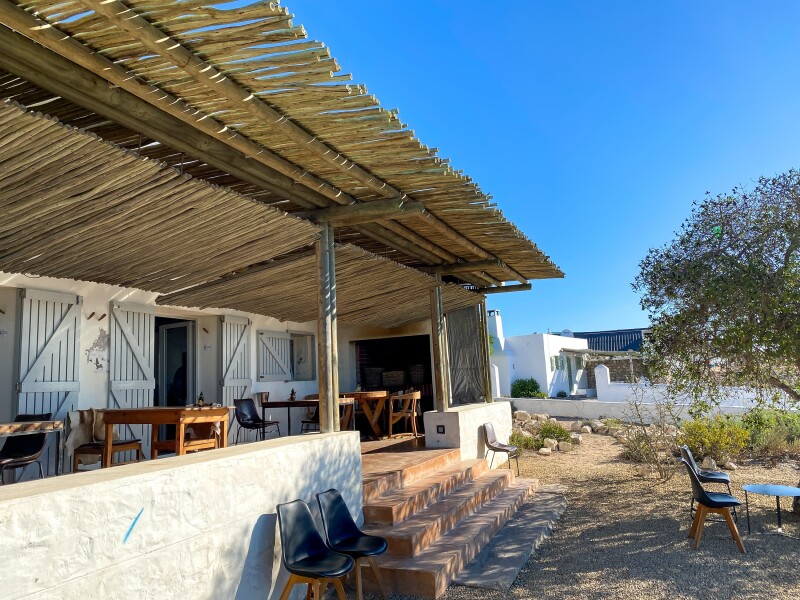There are special restaurants that can be a highlight of your vacation, whether Michelin-starred meals or no-frills spots, like taquerias, barbecue joints, or coastal seafood shacks. And then there’s an entirely different class of restaurant: ones that are so immersive, so life-changing, so one of a kind, that you could plan an entire trip around them. These are the places that inspire dedicated culinary pilgrimages, where you might have to secure your table reservation before you book a flight, and where making the trek is half the fun.
You may end up trying dishes and ingredients you’ve never heard of before, often made from ingredients found just outside the front door. Here, long, languid meals have a habit of turning into heady (and nerdy) chats with staffers about sourcing and sustainability or special visits to the gardens or impromptu tastings in the wine cellar. At some, you can even make a weekend out of it, thanks to on-site accommodations or activities like cooking classes and guided tours. The only problem? They often seat only a few diners at a time. In other words, start looking for a reservation now.
Kvitnes Gård
Kvitnes, Norway
You’ll have to head north of the Arctic Circle to reach Norway’s Vesterålen archipelago, which is like a less-discovered version of the neighboring Lofoten Islands. Up here, chef Halvar Ellingsen presides over a bustling farm and restaurant, where he raises a small menagerie that includes goats, ducks, and furry Mangalitsa pigs. Conditions in these parts are extreme—months of midnight sun, months of total darkness—so the team has to get creative with their planting and preservation techniques. But you don’t feel that ruggedness inside the snug, fire-warmed 1855 farmhouse, where dishes are artful (soup bowls shaped like seashells, courses plated atop piles of beach pebbles or evergreen branches), the cooking is modern yet approachable, and the ingredients are a window into the flavors of the fjords (moose, birch, minke whale). Spend the night in one of the 15 guest rooms so you can take advantage of the shorefront sauna or join the cooks on an organic farming tour the next day.

The Peruvian restaurant Mil takes culinary inspiration from the surrounding Sacred Valley.
Courtesy of Gustavo Vivanco Leon/Mil Centro
Mil
Moray, Peru
Chef Virgilio Martínez’s Central topped the World’s 50 Best list in 2023, but his restaurant Mil Centro, in the Sacred Valley, is perhaps an even more special dining experience. Opened in 2018 about an 80-minute drive northwest of Cusco, the restaurant sits at 11,700 feet above sea level, next to an Inca archaeological site called Moray. On-staff anthropologists work with members of the local Indigenous communities to learn about rare ingredients and ancestral foodways, and the resulting tasting menu is inspired by various micro-ecosystems at different altitudes, with ingredients like alpaca, tree tomato, plenty of varieties of tubers, and even chaco, an edible clay. A regular meal here usually lasts about two hours, but if you’re coming all this way, opt for the Immersion experience, which includes a guided tour of the ruins, a walk through the surrounding farmlands, foraging for ingredients and medicinal plants, and a tasting of ferments and spirits made from tubers, legumes, cereals, and roots.
Fauna
Valle de Guadalupe, Mexico
This experimental but appropriately laid-back restaurant in the Valle de Guadalupe wine region proves decisively that Baja Calfornia cuisine is more than fish tacos and ice-cold lagers. About 90 minutes outside of Tijuana or 45 minutes from Ensenada, Fauna is part of the Bruma Wine Resort, which includes vineyards, gardens, suites, and villas. Ensenada-born chef David Castro Hussong focuses on the savory dishes, which incorporate ingredients like lamb and quail from area farms and ranches; his wife, pastry chef Maribel Aldaco, works magic with desserts. Of course, the best way to experience their dishes is with a pairing of wines from this very vineyard: Think oysters with cayenne oil and tomato water paired with Plan B Sauvignon Blanc, or braised lamb with chilhuacle chili sauce served with a spicy Bastardo Montepulciano.

The tasting menus at Sauvage are an introduction to the wild ingredients of the Canadian Rockies.
Courtesy of Twin Studio/Silckerodt Photography
Sauvage
Canmore, Alberta
A gateway to Banff National Park and winter sports capital, Canmore might seem like a trail-mix-and-beef-jerky kind of town. But it’s also home to a surprisingly excellent restaurant scene that will remind you of Boulder. Sauvage occupies a heritage home downtown and is a cozy ode to the farmed, fished, foraged, and hunted ingredients of the Canadian mountains and prairie. There’s an à la carte menu, but the best move is to opt for one of the two tasting menus, which cost less than $90: the omnivorous Hunter menu and the vegan Gatherer menu. Ingredients include wild game like boar, pheasant, and venison, plus foraged botanicals such as pine, cattail, and Saskatoon berries. Equally impressive is the cocktail menu, arranged by Canadian regions, with drinks inspired by the flavors of each province. From the west, for instance, the Salt Bae includes samphire (salty succulents found along the coast), while the Something Corny? from the Prairies section includes wheat whiskey and corn from Taber, the “Corn Capital of Canada.”
Cuisine Régionale L’Évo
Nanto, Japan
There’s an almost Miyazaki-like whimsy to this remote mountainous area in the Toyama Prefecture (which is also part of our Where to Go in 2025 list), but it takes a bit of work to get here: The drive is roughly six hours from Tokyo or four hours from Kyoto, often along narrow winding passes with steep cliff drop-offs and snow throughout the colder months. Of course, the trek is part of what makes it special. Opened in 2014, Cuisine Régionale L’Évo moved to this village of about 500 people in 2020, and the minimalist space includes such artful touches as Toyama-made wood carvings and sea bream fish leather lamps.
As the name suggests, the technique skews French, but ingredients are not only Japanese but also hyper-specific to this region: Think cured Asian black bear meat, ooettyubai (sea snails), devil stinger fish, and fir needle paste. Adding to the uniqueness is a nonalcoholic drinks pairing, with mocktails and teas made from ingredients like sparkling mountain spring water, the kuro-moji tree, and wild mugwort. The lack of alcohol will come in handy if you want to tackle those mountain passes after the meal, but you could also stay over in one of the three on-site cottages, which offer access to a Finnish-style wood-fired sauna.

Chef Ana Roš has almost single-handedly turned Slovenia into a must-visit culinary destination.
Photo by Suzan Gabrijan
Hiša Franko
Kobarid, Slovenia
Few chefs have had as significant an impact on their country’s culinary reputation as Ana Roš has with Slovenia. Despite being self-taught, she has appeared on Netflix’s Chef’s Table and was voted the best female chef in the world by the World’s 50 Best list. All that praise has inspired adventurous diners to make special trips to Hiša Franko, in a tiny village in the Soča Valley, which feels like some undiscovered corner of Switzerland. Befitting this compact country’s position at the crossroads of Europe, its cuisine is a mix of Central, Southern, and Eastern European flavors, and Roš’s menu includes pastas and dumplings, local alpine cheeses from high-mountain pastures, and marble trout fished from nearby gorges. The hospitality is so warm that you’ll want to stay a while, and luckily, Hiša Franko offers 10 cheerful rooms in an 1861 countryside house.
Cabane à Sucre Au Pied de Cochon
Mirabel, Quebec
Carnivores have flocked to Montreal’s Au Pied de Cochon since it opened in 2001, but if you want to feel like you’re part of an exclusive club, snag a seat at chef Martin Picard’s seasonal “sugar shack.” Cabanes à sucre are spring-only restaurants that pop up during the maple harvest, when buckets of sap are boiled down into syrup, and Quebecers travel to the countryside in droves to indulge in hearty meals in rustic digs. Picard’s version is housed in a 19th-century log cabin in the Laurentian Mountains from mid-February to mid-May, and the fit-for-a-lumberjack menu often includes dishes like pork-and-duck shepherd’s pie, stuffed eggplant with smoked ham, and apple pie with foie gras and cheddar. For the full experience, gather 13 of your friends for “The Table in the Kitchen,” which is next to the stoves and includes a magnum of champagne for CAD$2,200 before tax and service; when you consider that that comes out to only about US$109 per person, it seems like practically a steal.

The Agrarian Kitchen’s bustling dining room is located in an old mental hospital; almost everything served at the restaurant, from bread to charcuterie, is made onsite.
Courtesy of the Agrarian Kitchen (left); Photo by Michelle Heimerman (right)
The Agrarian Kitchen
New Norfolk, Australia
Located a half-hour drive outside of the Tasmanian capital city of Hobart in the Derwent Valley, the Agrarian Kitchen occupies an unexpected historic building: an 1830s-era mental asylum that’s been transformed into a destination restaurant, cooking school, and events venue. Chef Stephen Peak sources 90 percent of ingredients from the on-site greenhouse and gardens, and staffers practice whole-animal butchery, make their own cheese and charcuterie, bake their own bread, and preserve and ferment seasonal produce. You can sample all of this craftsmanship in a multi-course tasting menu, paired with drinks (mostly) made by Tasmanian distillers, brewers, and winemakers, but if you don’t want to commit to a lengthy meal, the team also runs an outside kiosk selling sandwiches, salads, pastries, and cakes, meant to be enjoyed on the sunny lawn. Round out your experience with guided garden tours and classes focused on topics such as cheesemaking, baking croissants, and cooking with wild game.
Asador Etxebarri
Axpe, Spain
Spain is chockablock with Michelin stars, and many of its most notable chefs—especially in the Basque Country—are fans of molecular gastronomy and avant-garde culinary experimentation. Not so Victor Arguinzoniz, whose Asador Etxebarri recently ranked number two on the World’s 50 Best list. Set in a rustic 18th-century farmhouse in a Basque village 25 miles outside of Bilbao, this humble spot is centered around custom-fired grills where meat and seafood is cooked over wood from old barrels, oak, and even grapevines. Many people consider this one of the finest steakhouses anywhere, but beef isn’t the only ingredient that gets kissed by flames: The grills factor into every dish, from homemade chorizo and red Palamós prawns to a dessert of smoked milk ice cream with beet juice. The experience is earthy and practically spiritual, and food critics have written about how the meal made them cry.

The South African restaurant Wolfgat serves only 20 guests at a time on its breezy veranda.
Photo by Wirestock Creators/Shutterstock
Wolfgat
Paternoster, South Africa
The fishing village of Paternoster, about a two-hour drive north of Cape Town on South Africa’s western coast, is home to chef Kobus van der Merwe’s relaxed waterfront restaurant Wolfgat. By feeding only 20 diners per seating, the place is able to maintain its mission of sustainability, drawing on locally caught fish and shellfish, foraged wild herbs and succulents, and seaweed harvested from nearby rock pools. The vibe is decidedly beachy and unfussy, but you’ll be introduced to plenty of ingredients you probably haven’t tried before, such as springbok (an antelope and South Africa’s national animal) and bokkom, salted and dried mullet. The 130-year-old restaurant building is located on the site of an archaeologically significant cave system where ceramics, ostrich eggshells, beads, and stone artifacts were found, some dating back as much as 2,000 years. Keep your eyes on the restaurant’s Instagram page for scheduled walks through the Strandveld, an endangered coastal vegetation type found in this area.











